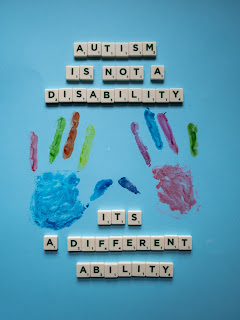April is OT Month but it is also Autism Awareness Month. I have had the pleasure of serving several kids with Autism. They have helped me look at the world with a new lens. They are some of the most amazing human beings that I know. In recent years, not only are people with Autism looking to bring awareness to Neurodiversity. They are also looking for acceptance. I recently created this flyer with Tips for people who are unfamiliar with engaging Autistic Children.
Tip #1 - Use simple language and visuals. Many children with Autism have language delays. Therefore using simple language and simple sentences helps with understanding. Most children with Autism are visual learners so using pictures (drawings or photos) to communicate with them and/or writing your message may be easier for the child with Autism to understand.Tip #2 - Use timers and prepare for transitions. Children with Autism can have difficulty with transitions or moving from one task or environment to another. Providing them with a timer to let them know when something is going to end or change is very helpful. There are several types of timers i.e. visual, sand, digital, auditory, etc. Learn what works best for the person whom you are working with. Using a visual schedule so they know what is next helps prepare for the transition as well. Sometimes I do something as simple as drawing and writing a schedule on a white board and let my student check or cross off the items as we go along. Other times, I may use a schedule made from SymbolStix, Boardmaker, Sensational Brains for sensory tasks, etc.
Tip #3 - Provide Movement Breaks. Children with Autism tend to perceive sensory input differently due to their neurological differences. Therefore, providing movement input tends to help them regulate. It also will increase their ability to sit and focus for short periods of time. Including movement in their learning is also recommended. Adding heavy work to the movement activities or after the movement activities may help with overstimulation as well. It's important to provide movement breaks throughout the day (every 25-30 minutes for 1-3 minutes). I have several children who love to take a walk. While walking, they may push a cart or carry a weighted bookbag. I also have children who love to jump on the trampoline or run a lap outside before returning to work. For whole class movement breaks, my students love GoNoodle. The simple ones that only require running, jumping and ducking (i.e. Run the read carpet and Fabio's Meatball Run) works best for students who have difficulty with gross motor coordination or motor planning. For smaller kids, animal walks, movement songs, dancing, riding a tricycle, spinning in an office chair and playground/recess time are my student's favorite movement activities.
Tip #4 - Provide a calming area. It is very helpful to design and designate an area as a calming area that is relaxing, has visuals to support deep breathing and examples of emotions, and has some preferred calming tasks. Showing the child the area when he/she is already calm and practicing going to the area to use the materials will be helpful when the child is upset. Every child is different so exploring a variety of calming items/ strategies to see what works best is needed in the beginning. Some children like soft music or noise cancelling headphones. Some children like to draw or color when calming down. Some kids can use a visual for deep breathing or a blow a pinwheel. There are some children that just want to sit on some soft pillows and zone out.
Tip #5 - use social stories. A social story is a description of an activity with pictures to help a child with Autism understand what will happen and what to expect. It also addresses what is the expected behavior for the child during the activity. These can be very helpful during novel situations to decrease anxiety and unwanted behaviors. For some kids, real pictures or videos are more helpful than picture drawings.
For more information or access to this handout, contact me at www.therapymomme.com









Comments
Post a Comment